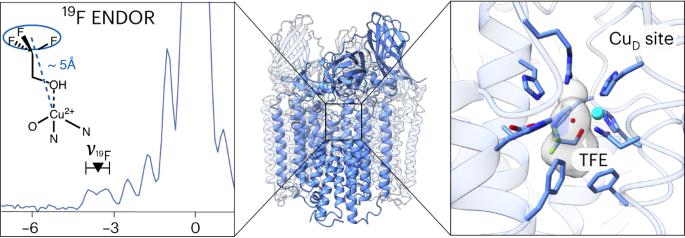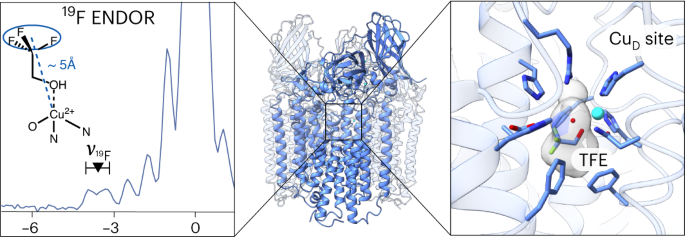Product analogue binding identifies the copper active site of particulate methane monooxygenase
IF 42.8
1区 化学
Q1 CHEMISTRY, PHYSICAL
引用次数: 0
Abstract
Nature’s primary methane-oxidizing enzyme, the membrane-bound particulate methane monooxygenase (pMMO), catalyses the oxidation of methane to methanol. Copper is required for pMMO activity, and decades of structural and spectroscopic studies have sought to identify the active site among three candidates: the CuB, CuC and CuD sites. Challenges associated with the isolation of active pMMO hindered identification of its catalytic centre; however, we have recently shown that reconstituting pMMO into native lipid nanodiscs stabilizes its structure and restores its activity. Here, such active samples were incubated with 2,2,2-trifluoroethanol, a product analogue that serves as a readily visualized active-site probe. Interactions between 2,2,2-trifluoroethanol and the CuD site were observed with pulsed electron nuclear double resonance spectroscopy and cryoelectron microscopy, implicating CuD and the surrounding hydrophobic pocket as the likely site of methane oxidation. Use of these orthogonal techniques on parallel samples is a powerful approach that can circumvent difficulties in interpreting metalloenzyme cryoelectron microscopy maps. Different locations have been proposed for the catalytic centre of particulate methane monooxygenase for methane oxidation to methanol. Now, cryoelectron microscopy structures and electron nuclear double resonance spectroscopic measurements of the enzyme with a product analogue identify CuD as the active site and provide insights into substrate binding.


产物类似物结合鉴定颗粒甲烷单加氧酶的铜活性位点
自然界的主要甲烷氧化酶,膜结合颗粒甲烷单加氧酶(pMMO),催化甲烷氧化为甲醇。铜是pMMO活性所必需的,几十年的结构和光谱研究试图在三个候选位点中鉴定活性位点:CuB、CuC和CuD位点。与活性pMMO的分离相关的挑战阻碍了其催化中心的鉴定;然而,我们最近已经表明,将pMMO重建成天然脂质纳米盘可以稳定其结构并恢复其活性。在这里,将这种活性样品与2,2,2-三氟乙醇孵育,该产物类似物用作易于观察的活性位点探针。用脉冲电子核双共振光谱和冷冻电子显微镜观察了2,2,2-三氟乙醇和CuD位点之间的相互作用,表明CuD和周围的疏水袋可能是甲烷氧化的位点。在平行样品上使用这些正交技术是一种强大的方法,可以避免解释金属酶冷冻电子显微镜图谱的困难。
本文章由计算机程序翻译,如有差异,请以英文原文为准。
求助全文
约1分钟内获得全文
求助全文
来源期刊

Nature Catalysis
Chemical Engineering-Bioengineering
CiteScore
52.10
自引率
1.10%
发文量
140
期刊介绍:
Nature Catalysis serves as a platform for researchers across chemistry and related fields, focusing on homogeneous catalysis, heterogeneous catalysis, and biocatalysts, encompassing both fundamental and applied studies. With a particular emphasis on advancing sustainable industries and processes, the journal provides comprehensive coverage of catalysis research, appealing to scientists, engineers, and researchers in academia and industry.
Maintaining the high standards of the Nature brand, Nature Catalysis boasts a dedicated team of professional editors, rigorous peer-review processes, and swift publication times, ensuring editorial independence and quality. The journal publishes work spanning heterogeneous catalysis, homogeneous catalysis, and biocatalysis, covering areas such as catalytic synthesis, mechanisms, characterization, computational studies, nanoparticle catalysis, electrocatalysis, photocatalysis, environmental catalysis, asymmetric catalysis, and various forms of organocatalysis.
 求助内容:
求助内容: 应助结果提醒方式:
应助结果提醒方式:


